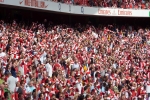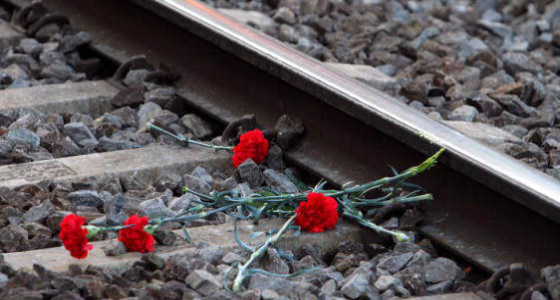
“I wish the people of Britain well,” says 52 year old Isabel Casanova, wiping her eyes, “but I can’t help thinking you’re next.”
At 7.15am on the 11th March this year, Isabel’s 22 year old son, Jorge, an avid Real Madrid fan, boarded a train with his father bound for Atocha station in central Madrid. Jorge was headed for his engineering class at college, his father for his office. Neither of them arrived. Twenty four minutes later at 7.39am as the train pulled out of Santa Eugenia station, the rucksack in the luggage rack above their heads exploded killing them both instantly along with thirty one others. In the following five minutes, along the next nine miles of track, the carnage continued. In three other trains, nine more identical rucksacks exploded, ripping through carriages packed with commuters making their way to work.
Timed specifically to occur exactly two and a half years after 9/11, this brutal terrorist attack, the worst on European soil since 270 people died at Lockerbie in 1988, was Spain’s 9/11 - or 11M as it soon became known. By the end of the most horrific day in Madrid’s long and colourful history, 191 people were dead, 1800 lay injured and countless lives had been plunged into despair.
In recent years, Al Quaeda’s sworn enemies, namely we in the West, have paid dearly for our decadent, un-Islamic ways and intusive forign policies. The Americans and the world lost 2,800 souls when the twin towers collapsed, the Australians 202 in the Bali Bombings in 2002, the Spanish 191 in Madrid and most recently the Russians 400, most of them children, after the school siege at Beslan. Geographically, it cannot be denied that meticulously planned attacks from Islamic fundamentalists are growing steadily closer to these shores.
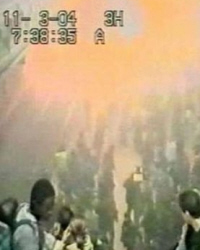 Equally as worrying is the fact that the Madrid bombings occurred three days before the Spanish general election with the specific intention of swaying the electorate into unseating the pro-Iraq war Prime Minister, Jose Maria Asnar who looked to be cruising to a second term in government. The attacks succeeded. In a sudden turnaround the Spanish people voted in Jose Zapatero who had campaigned on a promise to withdraw Spain’s troops from Iraq. With a general election for the pro-Iraq war Mr Blair just around the corner, it’s not only Isabel Casanova who thinks that Britain may be next. And if we are, how many will die and what convenient numerical moniker will it become known as? FHM flew two and a half hours to the Spanish capital of Madrid to witness for itself the devastating impact and aftermath of an Al Quaeda attack.
Equally as worrying is the fact that the Madrid bombings occurred three days before the Spanish general election with the specific intention of swaying the electorate into unseating the pro-Iraq war Prime Minister, Jose Maria Asnar who looked to be cruising to a second term in government. The attacks succeeded. In a sudden turnaround the Spanish people voted in Jose Zapatero who had campaigned on a promise to withdraw Spain’s troops from Iraq. With a general election for the pro-Iraq war Mr Blair just around the corner, it’s not only Isabel Casanova who thinks that Britain may be next. And if we are, how many will die and what convenient numerical moniker will it become known as? FHM flew two and a half hours to the Spanish capital of Madrid to witness for itself the devastating impact and aftermath of an Al Quaeda attack. “I was still in bed when my older son Javier phoned me,” continues Isabel across her dining room table. It’s an overcast morning in October and she has invited FHM into her seventh floor flat in Alcala de Henares, a suburb fifteen miles east of Madrid, “he told me to turn on the TV and I saw the terrible pictures of exploded trains and immediately tried to call my son and ex-husband. There was no reply.”
The previous day when speaking to a fireman who helped remove the bodies of seventy people from a train at El Poso station, he told us that what haunts him most is not what he saw but what he heard: “There was this constant ringing of mobile phones as I picked through all the body parts,” he explained gazing intently into the distance over my shoulder, “it is a sound I will never forget.”
Isabel tells us how she phoned her son and ex-husband throughout the day with no luck. “My other son Javier spent the whole day visiting all the hospitals but was unable to find anything about them.” Then at eight in the evening, she received a call asking for somebody to go to Madrid’s convention centre with photographs of the missing. Her husband went and at five o'clock in the morning, amidst the chaos of hundreds of confused, distraught and grieving families, he identified the remains of Jorge and his dad.
On the mantelpiece above us sits a large, framed photograph of Isabel and her three children. She picks it up and points out Jorge. “His favourite player was Zinedine Zidane,” she musters a smile, “so at his funeral Javier, put a Real Madrid shirt with Zidane’s name on it over his body.” She goes on to explain how a journalist at the funeral told the football club about what happened and how Zidane himself phoned her and invited Javier to a game. “Javier watched the game sitting next to the president Real Madrid,” she recalls, “Zidane scored a goal and at the end of the match he took off his shirt, found Javier and presented him with his shirt in memory of his dead brother. I’ll show you.” She returns carrying a large frame containing Zidane’s grass stained shirt. It’s difficult to think of anything to say and even if there is something, it’s difficult to speak.
Then she ushers Anthony the photographer and I, down the corridor to Jorge’s bedroom. At the end of his bed sits Homer Simpson wearing a football shirt with “Jorge” on his back – the same shirt that Jorge’s school football team now wear for every match in his memory. His CD’s sit unplayed, his Lord Of The Rings video unwatched and his aftershave unused. From the walls, photos of him as baby, boy, youth and man look down on us and it’s very difficult for Anthony and I to hold it together.

It’s a short taxi ride from Isabel’s flat to Alcala de Henares station where we board the same train Jorge took some seven months ago. Three of the four doomed trains bound for central Madrid started their journey from this station whilst the fourth stopped here on its way through. This is where the bombers boarded each train with their deadly cargo of backpacks stuffed with 10kgs of tidadine, a compressed form of dynamite, before getting off at the next stop.
In the immediate aftermath of the bombings the Spanish government pointed the finger of blame squarely at ETA, Spain’s Basque separatist terrorists who have mounted a long and often bloody campaign of independence for their Basque region in northern Spain. Later in the day however, an Al Quaeda linked group claimed responsibility in an email sent to a London-based Arabic newspaper: “This is part of settling old accounts with Spain the crusader,” it said, “and America’s ally in it’s war against Islam. Who will protect you Britain, Japan, Italy and others from us?” the statement continued before announcing that another major strike against America was “90% ready”.
Within hours of the attack an abandoned van was found parked near Alcala De Henares station containing eight detonators and an Arabic tape of verses from the Koran. The finger of blame now pointed directly at Al Qaeda and also at the Spanish Prime Minister who was roundly accused of trying to cover up the link to avoid defeat in the forthcoming election.
As our train pulls out of Alcala de Henares, Anto and I have to admit to feeling slightly anxious. The train is packed with people and we can’t help but notice that it’s packed with rucksacks too. We stop at the stations of Coslada and Vicalvara before pulling up at Santa Eugenia where Jorge and his father died.
The previous evening we had caught a taxi to a shopping mall very near here where forty six year old nurse Clara Escrebano Arenas beamed with pride as she showed us around the new headquarters of the support group she started: “Asociacion Affectados Del Terrorism.” On that morning in March she boarded Jorge’s train to go to work and walked straight past the bomb as she made her way to the end of the fourth carriage. “The last thing I remember was the beeping of the closing doors,” she says as we order a beer at a nearby café, “and then BANG!” Clara regained consciousness five minutes later covered in debris, bleeding heavily from a neck wound, unable to talk and aware that she had wet herself. “Five people carried me out and laid me on the ground,” she explains shaking her head, “and I was surrounded by dead bodies.” I ask her about the long term effects of her ordeal and she pulls two X ray photographs out of a large envelope and holds them up to the light. “These two pieces of shrapnel are too close to my spine to be removed,” she says pointing at two solid shapes in her neck, “and I still can’t face going back to that station or any station for that matter.”
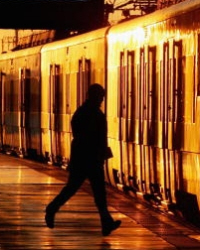 The closing doors beep their warning and we pull away from Santa Eugenia. They open again some four miles further down the track at the station of El Pozo. It was here that two bombs exploded on board a double decker train killing seventy people, one of whom was found on the station roof. One of the first firemen to arrive at the scene was 45 year old Miguel Lopez of the 8th Valletas who we tracked down the previous day at his fire station. “In 16 years I’ve never seen anything like it,” he shrugged dejectedly, “as we approached the station we started to see body parts on the platform. We split into pairs and set about getting survivors out of the wreckage. In the upstairs part of the train you couldn’t recognise what was left as human beings.” Miguel goes on to explain how a difficult job got more difficult when one of his colleagues discovered two unexploded bombs in neighbouring carriages thought to have been intended for the rescue workers. Whilst one of the backpacks was destroyed by controlled explosion, the other was left to Pedro Lorente, a bomb disposal expert who heroically asked permission to try and diffuse it. Lorente drove the bomb to a nearby park where, whilst praying to himself, he detached the wires linking the explosives to the detonator and it’s mobile phone trigger. The SIM card found inside led police to the vendors and eventually to the bombers themselves.
The closing doors beep their warning and we pull away from Santa Eugenia. They open again some four miles further down the track at the station of El Pozo. It was here that two bombs exploded on board a double decker train killing seventy people, one of whom was found on the station roof. One of the first firemen to arrive at the scene was 45 year old Miguel Lopez of the 8th Valletas who we tracked down the previous day at his fire station. “In 16 years I’ve never seen anything like it,” he shrugged dejectedly, “as we approached the station we started to see body parts on the platform. We split into pairs and set about getting survivors out of the wreckage. In the upstairs part of the train you couldn’t recognise what was left as human beings.” Miguel goes on to explain how a difficult job got more difficult when one of his colleagues discovered two unexploded bombs in neighbouring carriages thought to have been intended for the rescue workers. Whilst one of the backpacks was destroyed by controlled explosion, the other was left to Pedro Lorente, a bomb disposal expert who heroically asked permission to try and diffuse it. Lorente drove the bomb to a nearby park where, whilst praying to himself, he detached the wires linking the explosives to the detonator and it’s mobile phone trigger. The SIM card found inside led police to the vendors and eventually to the bombers themselves. A single strip of fading police tape across the gate is the only sign that this quiet little house in Chincon, 25 miles from Madrid, is linked to the bombings. It was here that 33 year old Hamed Sayed Osman Rabei, a former Egyptian army explosives expert, assembled his team of small time crooks and deluded university graduates to study train timetables and plan their attack. Funded by a Saudi cleric, he was arrested along with eight other suspects who join twenty other men, mostly Morrocans who have been charged with in relation to the bombings. Seven others blew themselves up, killing one police officer, when they were surrounded in a flat in Madrid on April 3rd. Phone taps and confessions have revealed the pitiful fact that the Spanish dynamite and detonators used by the bombers were bought on the black market for £4000 and a quantity of Moroccan hash.
We leave El Pozo and get off the train some ten minutes later onto platform two at Atocha station in the heart of Madrid. It was here in carriages three, four and six that three bombs exploded over a period of thirteen seconds as the train sat in the station. As our train leaves to continue its journey, it reveals a large gauge scarred out of the concrete between the tracks where the sixth carriage had been standing.
Upstairs we meet with fifty year old Pablo Torres, a journalist who happened to be on a train behind the fourth train that was ripped apart by four bombs 500 yards outside Atocha station. Using his digital camera he took a series of graphic photographs of the immediate aftermath, one of which was used on the front page of virtually every major newspaper in the world. Out of a plastic bag he pulls out the framed original of this very photograph. It shows all four bomb blasts and the survivors tending to the dying and the injured. In the foreground next to the track is a large lump of red meat.
“What’s that?” I ask.
“Somebody's thigh,” he replies.
For some papers like The Daily Telegraph this was too graphic and they ran the photo with the body part digitally removed. Others like The Guardian kept the image but removed the colour. Others still, bravely ran it as it was, showing the stak and sickening truth of what bombs do to humans.
Pablo agrees to take us to where he took the photo so we follow him down a road, through a hole in a fence and over a wall until we are standing right next to the track. “I took sixty two photographs that day,” he explains as a train thunders past, “I felt it was important to record the truth of what happened.” We retire to a nearby café where Pablo tells us how psychiatric counselling has helped him deal with a day in which he witnessed life as well as death: “When I eventually got to my office my wife called to say my niece had just been born so I took the same camera straight to the hospital and took pictures of her too. Look!” He grins as he shows us pictures of a new born baby.
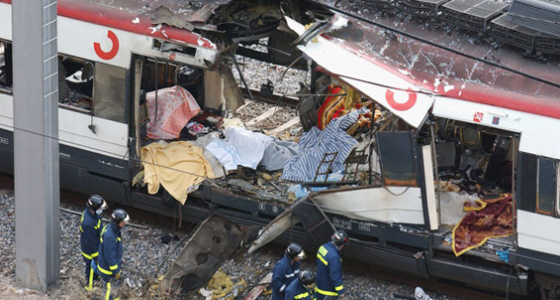
The next morning Anto and I take a taxi to the Feria De Madrid, a huge convention centre on the outskirts of Madrid where all the bodies were taken for identification. We are met at the entrance by twenty eight year old picture researcher Eva Gonzalez. “I had just arrived at work when I got a call from a relative telling me what had happened,” she explains, “she said she was worried because she couldn’t contact my cousin Andrea.” A long day of frantic phone calls ensued until at six that evening Eva drove here fearing the worst. “It was the most horrible sight. There were thousands of people frantically searching for loved ones. It was total chaos and confusion and all the time more bodies were arriving.” After nearly four hours of waiting Eva was taken down to Hall Six and shown to where the bodies recovered from Santa Eugenia were laid out. “I had a psychologist by my side and a man pulled back the sheets on maybe fifteen bodies until I saw Andrea - her face was covered with blood.” If this ordeal wasn’t bad enough Eva then had to call her Aunt in Argentina to tell her that her daughter was dead. Tragically the grief was to prove too much for her and two months later Eva’s Aunt committed suicide – yet another victim of the bombings.
We are joined by 23 year old journalist Juan Silvestre who bravely volunteered to work here that night. “I used to work here on the information desk,” he explains as he shows us inside, “so when they appealed on television for people to help with the families, I just felt I had to go.” He takes us to the north entrance where he met the families before taking them up to the waiting rooms. “I’d answer questions, check hospital lists, get food and drink and just be with them until they were called down to identify the bodies. I couldn’t go down with them, I just couldn’t face it. It was too hard.” Having shown us around the waiting rooms he takes us downstairs into Hall 6 itself. A huge empty building much like an aircraft hangar, our footsteps echo ominously around it’s walls and the atmosphere is heavy and unsettling. For Eva, its an emotional experience. “The sound of so many people crying and screaming here is something that will never leave me,” she says as we turn to leave.
Outside Anto and I say our goodbyes to Eva and Juan and catch a cab to the airport. As we go, we leave Madrid and all it’s pain and suffering behind us. The question for us in Britain now is what lies ahead?
The answer arrives in 7/7 2005.
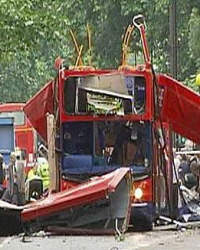
© Words Piers Hernu – First Appeared in FHM August 2005
Used by Kind Permission





